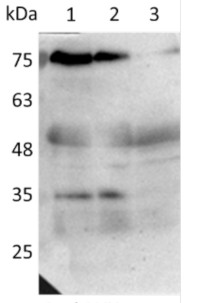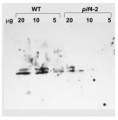1

Anti-LUX | Transcription factor LUX
AS16 4106 | Clonality: Polyclonal | Host: Rabbit | Reactivity: Arabidopsis thaliana
- Product Info
-
Immunogen: KLH-conjugated synthetic peptide derived from Arabidopsis thaliana LUX protein Q9SNB4, At3g46640
Host: Rabbit Clonality: Polyclonal Purity: Antigen affinity purified serum in PBS, pH 7.4 Format: Lyophilized Quantity: 50 µg Reconstitution: For reconstitution add 50 µl of sterile water.
Storage: Store lyophilized/reconstituted at -20°C; once reconstituted make aliquots to avoid repeated freeze-thaw cycles. Please, remember to spin tubes briefly prior to opening them to avoid any losses that might occur from lyophilized material adhering to the cap or sides of the tubes.
Tested applications: Western blot (WB) Recommended dilution: 1: 2000 (WB) Expected | apparent MW: 34.7 kDa - Reactivity
-
Confirmed reactivity: Arabidopsis thaliana
Predicted reactivity: Brassica napus, Camelina sativa, Capsella rubella, Eutrema salsugineum, Raphanus sativus
Species of your interest not listed? Contact us
Not reactive in: No confirmed exceptions from predicted reactivity are currently known.
- Application Examples
-

Samples:
1- 50 µg pEG202-LUX/Col-0 (FLAG-tag)
2- 50 µg Col-0
3- 50 µg lux mutant (SALK_119768) Expected product size: LUX (35kDa) and FLAG-LUX (35+1=36kDa)
All samples were 7-day-old seedlings grown under 22°C 16 light/8 dark.50 µg/well of total protein extracted freshly from Arabidopsis thaliana seedlings. Exact buffer components were: and denatured with 100 mM Tris-HCl, pH7.8, 4 M Urea, 5% SDS, 15% glycerol, protease inhibitor cocktail, β-Mercaptoethanol, and bromophenol blue dye at 100°C/10 min. Samples were separated in the cold on 10% SDS-PAGE and blotted to Immobilon®-P PVDF Membrane PVDF (pore size of 0.45 µm), using: wet transfer in the cold. Blot was blocked with 5 % milk 4°C/ON with agitation. Blot was incubated in the primary antibody at a dilution of 1:2000 for 1h with agitation in TBS-T with agitation. The antibody solution was decanted, and the blot was rinsed briefly twice, then washed once for 15 min and 3 times for 5 min in TBS-T at RT with agitation. Blot was incubated in matching secondary antibody (anti-rabbit HRP conjugated) diluted to 1:25 000 in TBS-T for 1h/RT with agitation. The blot was washed as above and developed with a chemiluminescent detection reagent: Agrisera Super Bright (AS16 ECL-S-10). Exposure time was 5 sec.
Courtesy of Dr. Chin-Mei Lee, Institute of Plant Biology Global Agriculture Technology and Genomic Science Master Program, National Taiwan University, Taiwan
- Background
-
Background: LUX (Transcription factor) essential for the generation of the circadian clock oscillation and activation of CCA1 and LHY expression. It is coregulated with TOC1 and seems to be repressed by CCA1 and LHY by direct binding of these proteins to the evening element in the LUX promoter. Binds to ELF3 and associates with ELF4 in a diurnal complex which is required for the expression of the growth-promoting transcription factors PIF4 and PIF5 and subsequent hypocotyl growth in the early evening.
Alternative names: Protein LUX ARRHYTHMO, Protein PHYTOCLOCK 1. - Protocols
-
Agrisera Western Blot protocol and video tutorials
Protocols to work with plant and algal protein extracts
Agrisera Educational Posters Collection
- Reviews:
-
This product doesn't have any reviews.



